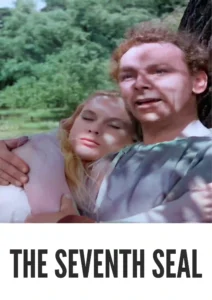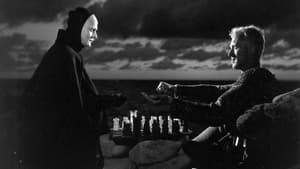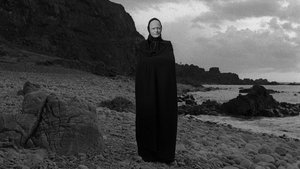Contact: info@alwanfilm.com
Video Sources 0 Views
- Watch trailer
- The Seventh Seal


Synopsis
Table of Contents
ToggleEmbracing Death: A Review of The Seventh Seal 1957 Colorized

Introduction
In the annals of classic cinema, few films evoke as much contemplation and intrigue as “The Seventh Seal 1957.” Directed by the visionary Ingmar Bergman, this existential masterpiece has captivated audiences for decades with its haunting imagery and profound exploration of life, death, and the human condition. Now, with the release of an early colored version, viewers have the opportunity to rediscover this cinematic gem in a new light. In this comprehensive review, we delve into the world of “The Seventh Seal 1957,” examining its director’s vision, the stellar cast, and the controversy surrounding its colorized release.
Check The Full Colorized Movies List
Check Our Colorized Movies Trailer Channel
Understanding The Seventh Seal 1957 Colorized: Director, Cast, and Genre
Ingmar Bergman’s “The Seventh Seal” is a seminal work of art-house cinema, renowned for its stark visuals and philosophical depth. Set against the backdrop of the Black Death ravaging medieval Europe, the film follows a disillusioned knight, Antonius Block, played by Max von Sydow, as he engages in a high-stakes game of chess with Death himself. Bergman’s direction imbues the film with a sense of existential dread, as Block grapples with questions of faith, mortality, and the meaning of existence.
The cast of “The Seventh Seal” delivers performances of unparalleled intensity, with Max von Sydow’s portrayal of Antonius Block standing as a masterclass in restrained anguish. Alongside von Sydow, Bengt Ekerot delivers a chilling performance as Death, his piercing gaze and stoic demeanor haunting every frame of the film. With its blend of historical drama and existential meditation, “The Seventh Seal” defies easy categorization, establishing itself as a seminal work within the realm of art-house cinema.
Exploring the World of The Seventh Seal 1957 Colorized: Plot and Characters
“The Seventh Seal” unfolds with an air of foreboding as Antonius Block, a disillusioned knight returning from the Crusades, encounters Death on a desolate beach. In a desperate bid to stave off his inevitable demise, Block challenges Death to a game of chess, hoping to prolong his life long enough to find meaning in a world plagued by suffering and despair.
As Block and his squire, Jöns, journey through the countryside, they encounter a cast of characters grappling with their own existential crises. From a troupe of traveling actors to a group of flagellants seeking absolution through pain, each encounter serves as a meditation on the human condition, highlighting the fragility of life and the inevitability of death.
The Art of Film Colorization
Film colorization has long been a contentious issue within the film industry, with purists arguing that it detracts from the integrity of the original work. However, proponents of colorization contend that it offers a fresh perspective on classic films, allowing audiences to engage with them in new and exciting ways. The process involves digitally adding color to black and white films, with varying degrees of success depending on the technology and techniques used.
Early Colored Films: A Brief History
The history of colorization can be traced back to the early days of cinema, with filmmakers experimenting with hand-painted frames and tinting techniques to add color to their films. However, it wasn’t until the advent of advanced digital technologies in the late 20th century that colorization became a widespread practice in the industry.
The Seventh Seal 1957 and Its Early Colored Version
In a bold move, the producers of “The Seventh Seal” opted to release an early colored version of the film, hoping to attract new audiences and introduce them to Bergman’s visionary work. While some purists may balk at the idea of tampering with a cinematic classic, others see it as an opportunity to breathe new life into a timeless masterpiece.
The Debate Over Film Colorization
The debate over film colorization has raged for decades, with passionate arguments on both sides of the issue. While some argue that colorization offers a fresh perspective on classic films, others contend that it undermines the artistic integrity of the original work, robbing it of its intended impact and emotional resonance.
Examining The Seventh Seal 1957 as an Early Colored Film
As with any colorized classic, the question remains: does the addition of color enhance or detract from the viewing experience? In the case of “The Seventh Seal 1957,” the early colored version offers a visually striking interpretation of Bergman’s haunting imagery, with vibrant hues and rich textures adding depth to the film’s atmospheric cinematography. While purists may prefer the original black and white version, the colorized edition provides an opportunity for new audiences to engage with Bergman’s timeless themes and cinematic artistry.
Influence and Legacy: The Seventh Seal 1957 Colorized’s Impact on Cinema
“The Seventh Seal 1957” stands as a towering achievement in the realm of art-house cinema, inspiring generations of filmmakers and establishing Bergman as one of the medium’s greatest auteurs. Its exploration of existential themes and stark visual style have left an indelible mark on the world of cinema, influencing countless directors and shaping the course of film history.
Director’s Cinematic Legacy: Beyond The Seventh Seal 1957 Colorized
Ingmar Bergman’s contributions to cinema extend far beyond “The Seventh Seal,” with a body of work that includes such masterpieces as “Persona,” “Wild Strawberries,” and “Fanny and Alexander.” His keen insight into the human psyche and uncompromising exploration of existential themes have earned him a place among the most revered filmmakers of all time.
Themes Explored in The Seventh Seal 1957 Colorized
“The Seventh Seal” delves into a myriad of existential themes, including the search for meaning in a seemingly indifferent universe, the nature of faith and doubt, and the inevitability of death. Through its richly drawn characters and haunting imagery, the film offers a profound meditation on the human condition, challenging audiences to confront their deepest fears and uncertainties.
Reception and Controversy Surrounding The Seventh Seal 1957 Colorized
Upon its release, “The Seventh Seal 1957” received widespread critical acclaim, with many praising Bergman’s visionary direction and the film’s profound exploration of existential themes. However, the decision to release an early colored version of the film has sparked debate among cinephiles, with some embracing the opportunity to experience the classic in a new way and others expressing reservations about the integrity of the original work.
Where to Watch The Seventh Seal 1957 Colorized Online
For those eager to experience the haunting beauty of “The Seventh Seal 1957,” the film is readily available on popular streaming platforms such as Amazon Prime, iTunes, and Google Play. Whether viewed in its original black and white format or the early colored version, audiences are sure to be captivated by its stark visuals, haunting imagery, and profound exploration of the human condition.
FAQs About The Seventh Seal 1957 Colorized
- Q: What inspired Ingmar Bergman to create “The Seventh Seal”?
- A: Bergman drew inspiration from his own experiences with death and existential angst, as well as medieval art and literature.
- Q: Is “The Seventh Seal” suitable for all audiences?
- A: While the film deals with mature themes and contains some disturbing imagery, it is considered a masterpiece of world cinema and is widely regarded as essential viewing for cinephiles.
- Q: How does the early colored version of “The Seventh Seal” compare to the original black and white version?
- A: While purists may prefer the original black and white version, the early colored edition offers a visually striking interpretation of Bergman’s haunting imagery, with vibrant hues and rich textures adding depth to the film’s atmospheric cinematography.
Conclusion
In conclusion, “The Seventh Seal 1957” stands as a timeless masterpiece of cinema, revered for its haunting imagery, profound exploration of existential themes, and visionary direction by Ingmar Bergman. Whether viewed in its original black and white format or the early colored version, the film continues to captivate audiences, offering a thought-provoking meditation on the human condition and the nature of existence.
While the debate over film colorization may persist, one thing remains certain: the enduring legacy of “The Seventh Seal 1957” is a testament to its status as a cinematic classic for the ages. So, whether you’re a seasoned cinephile or a newcomer to the world of classic cinema, be sure to experience the haunting beauty of “The Seventh Seal 1957” for yourself, and discover why it remains an essential entry in the annals of cinematic history.




















